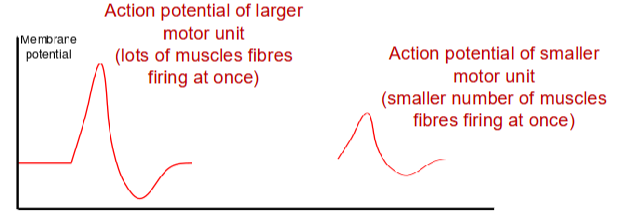BS1060 Block 6- Spinal cord and motor control
1/38
There's no tags or description
Looks like no tags are added yet.
Name | Mastery | Learn | Test | Matching | Spaced |
|---|
No study sessions yet.
39 Terms
What are the control systems of movement?
Motor-controlling the level of force
Sensory-feedback of movement/angle/force generated
What are alpha motor neurons?
Cell bodies found in the ventral horn of the spinal cord. They control every movement in the body.
How is the spinal cord similar to the central nervous system tissue?
It does not recover after trauma, and is heavily protected by the spinal column
What are the components of spinal cord anatomy?
Roots-origin of peripheral nerves
White matter-ascending and descending neuronal pathways up to and down from the brain
Gray matter-neuron cell bodies
What happens in motor neuron disease?
It affects alpha motor neurons in the spinal cord, which causes a loss of body movements
What is the motor unit?
The smallest unit in controlling movement. Made up of 1 alpha motor neuron and 1 single axon. It is also connected to muscle fibres to allow nerves to pass through
What are the two sizes of motor unit?
Small Motor unit and Large motor unit
Describe a small motor unit
1 alpha motor neuron and a few muscle fibres, allowing for precise control of small movements. On average around 100 muscle fibres
Describe a large motor unit
1 alpha motor neuron and many muscle fibres, enabling powerful contractions for larger movements. on average around 2000 muscle fibres
What are the 3 speeds of motor unit?
Slow (S), Fast Fatigable (FF), Fast Fatigue-Resistant (FR)
Describe slow motor units
Slow contracting, aerobic, very fatigue resistant, very small force
Describe Fast fatigable motor units
Fast contracting, easily fatigued, anaerobic, and generate high force.
Describe Fast fatigue resistant motor unit
Faster contracting, resistant to fatigue, mainly aerobic , and generates low force.
Describe the limitation of motor units based on capacity
Only a certain number of motor are available in each muscle for controlling a particular movement
What do we change to control force in muscle?
The rate of motor unit firing, the amount of motor units firing and the firing size of the motor neurons.
How does frequency coding effect the size of force in the muscle?
The frequency of action potentials firing is used to code the intensity for motor and sensory signals
How does the recruitment of additional motor units increase force in the muscle?
It activates more motor units: the greater the number of motor units firing, the greater the tension generated
How does the recruitment order of adding successively larger motor units increase the force in the muscle?
It follows the size principle: smaller motor units are recruited first for low-force tasks, and as force requirements increase, larger motor units are activated, resulting in greater muscle tension.
What is the cerebellum responsible for?
Error correction and learning movements
What are the basal ganglia responsible for?
Movement selection
What controls the alpha motor neurons?
The primary motor cortex
What systems ensure we are aware of where our body is in space?
Vision, vestibular system, proprioception & efference copy
What are the components of vision that help with awareness?
Dorsal stream-the ‘where’ pathway
Ventra stream- the ‘what pathway’
What is the main component of the vestibular system?
The ear-contains the vestibules (balance) and the cochlea (hearing). Used to sense translational and rotational movements.
What’s an Otilith?
A Calcium carbonate structure in the inner ear that helps detect changes in head position and motion, contributing to balance and spatial orientation.
Contains Utricle (horizontal plane) and saccule (vertical)
Provides inertia- embedded hair cells detect relative movement of the otoliths and detect direction of gravity.
What is proprioception?
The body's ability to sense its position and movement in space.
Give examples of important proprioceptors
Muscle spindles-muscle length and stretch sensors
Golgi tendon organs-muscle tension (or force) sensors
Describe muscle spindle fibres
Sensory fibres wrapped around muscle fibres (intrafusal fibres), arranged in parallel with muscle.
What are the two types of sensory fibre?
Type Ia afferents-detect change in length (joint movement) and Type II afferents- measure muscle length-detects the angle of joints
Describe Golgi tendon organs
Sensory fibres embedded in tendon of muscle, arranged in series with muscle. Detect muscle tension and forces applied to joints
What is efference copy?
A neural signal sent from the motor cortex to the sensory systems that predicts the outcome of motor commands. It helps the brain distinguish between self-generated movements and external stimuli.
List advantages of efference copy
Good for controlling fast movements
Good for movements which are not usually affected by external forces
Give disadvantages of efference copy
Doesn’t allow for unexpected changes
No absolute reference
less accurate for slower movements
Outline the stretch reflex
Muscle spindle stretched, afferent neuron fires
Monosynaptic connection in spinal cord-contraction of agonist muscle
Inhibition of antagonist muscle using inhibitory interneuron
Why is the stretch reflex important?
It transfers motor control to the spinal cord
It improves the speed of response and helps maintain posture and balance.
Outline the the recording motor unit activity using electromyography (EMG)
Record electrical activity in a muscle
Surface electrodes
Records all motor units in a muscle.
What do the EMG recordings of motor units look like?
Action potential waveforms representing muscle activation. They measure the action potentials of all muscle fibres in the motor units.

What does estimating motor conduction velocity indicate?
CMAP- Compound Muscle Action Potential, which measures the speed of electrical signals along the motor pathways.
Why is the subtractive methods used?
The neuromuscular junction- adds on 0.5-0.8 milliseconds
The terminal branches are unmyelinated, and thinner, so axonal conduction was slower